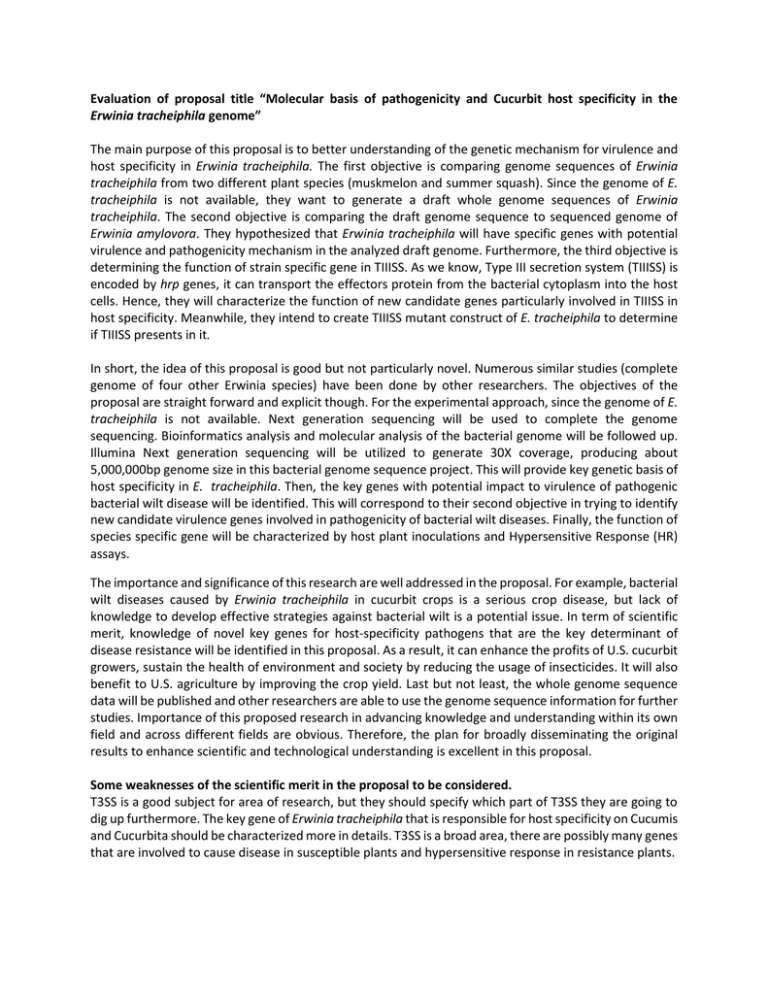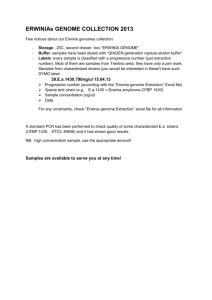Document 10763073
advertisement

Evaluation of proposal title “Molecular basis of pathogenicity and Cucurbit host specificity in the Erwinia tracheiphila genome” The main purpose of this proposal is to better understanding of the genetic mechanism for virulence and host specificity in Erwinia tracheiphila. The first objective is comparing genome sequences of Erwinia tracheiphila from two different plant species (muskmelon and summer squash). Since the genome of E. tracheiphila is not available, they want to generate a draft whole genome sequences of Erwinia tracheiphila. The second objective is comparing the draft genome sequence to sequenced genome of Erwinia amylovora. They hypothesized that Erwinia tracheiphila will have specific genes with potential virulence and pathogenicity mechanism in the analyzed draft genome. Furthermore, the third objective is determining the function of strain specific gene in TIIISS. As we know, Type III secretion system (TIIISS) is encoded by hrp genes, it can transport the effectors protein from the bacterial cytoplasm into the host cells. Hence, they will characterize the function of new candidate genes particularly involved in TIIISS in host specificity. Meanwhile, they intend to create TIIISS mutant construct of E. tracheiphila to determine if TIIISS presents in it. In short, the idea of this proposal is good but not particularly novel. Numerous similar studies (complete genome of four other Erwinia species) have been done by other researchers. The objectives of the proposal are straight forward and explicit though. For the experimental approach, since the genome of E. tracheiphila is not available. Next generation sequencing will be used to complete the genome sequencing. Bioinformatics analysis and molecular analysis of the bacterial genome will be followed up. Illumina Next generation sequencing will be utilized to generate 30X coverage, producing about 5,000,000bp genome size in this bacterial genome sequence project. This will provide key genetic basis of host specificity in E. tracheiphila. Then, the key genes with potential impact to virulence of pathogenic bacterial wilt disease will be identified. This will correspond to their second objective in trying to identify new candidate virulence genes involved in pathogenicity of bacterial wilt diseases. Finally, the function of species specific gene will be characterized by host plant inoculations and Hypersensitive Response (HR) assays. The importance and significance of this research are well addressed in the proposal. For example, bacterial wilt diseases caused by Erwinia tracheiphila in cucurbit crops is a serious crop disease, but lack of knowledge to develop effective strategies against bacterial wilt is a potential issue. In term of scientific merit, knowledge of novel key genes for host-specificity pathogens that are the key determinant of disease resistance will be identified in this proposal. As a result, it can enhance the profits of U.S. cucurbit growers, sustain the health of environment and society by reducing the usage of insecticides. It will also benefit to U.S. agriculture by improving the crop yield. Last but not least, the whole genome sequence data will be published and other researchers are able to use the genome sequence information for further studies. Importance of this proposed research in advancing knowledge and understanding within its own field and across different fields are obvious. Therefore, the plan for broadly disseminating the original results to enhance scientific and technological understanding is excellent in this proposal. Some weaknesses of the scientific merit in the proposal to be considered. T3SS is a good subject for area of research, but they should specify which part of T3SS they are going to dig up furthermore. The key gene of Erwinia tracheiphila that is responsible for host specificity on Cucumis and Cucurbita should be characterized more in details. T3SS is a broad area, there are possibly many genes that are involved to cause disease in susceptible plants and hypersensitive response in resistance plants. In the proposal, they mentioned that it is difficult to isolate the bacteria from the wilting host, is there a way to improve that? Is there a way to modify and revise the methods of isolation of Erwinia tracheiphila strain from wilting muskmelon and squash? That will be the concerns of reviewers. They may need to provide alternative strategies to resolve this problem. On the other hand, the proposal should mention what is the expected sequencing results, how complete are the sequencing results if compared to the reference genome, is there any region in the genome that is GC rich and hard to amplify? Is there a downside of using Next Generation Sequencing, the proposal should notify some of them for further improvement. Also, some discussion of potential pitfalls of their proposed methodology and presentation of alternative approaches would be helpful in this proposal. Moreover, this proposal may raise the readers’ curiosity, are they going to use the comparative genomic approach to analyze and create the T3SS mutant construct of E. tracheiphila even though the genome of this plant pathogenic bacterium is not available yet, are they specifically create mutant in hrp genes or other genes (such as the Dsp A/ E, eop1 etc.) In my point of view, they are supposed to be emphasized in a more specific way in the proposal. Apart from this, the phylogenetic relationship among the four Erwinia species (E. amylovora, E. pyrifoliae, E. tasmaniensis and E. biliangiae) in term of evolutionary points of view should be briefly mentioned in the background section, otherwise, it will not make sense to compare within these four sub-species in the proposal. Some strengths of the scientific merit in the proposal It is known that the bacterial wilt disease causes major financial losses in the U.S. agriculture, the genome sequencing results of the Erwinia tracheiphila will definitely plan for broadly disseminating the results to enhance scientific and technological understanding of the wilt disease. This will always be the broader impacts of the proposal. On the other hand, TIIISS is a good research area since it is a common secretion system used by gram-negative bacteria to colonize their host, this will have a huge implication to the area of research. The description of the suitability and feasibility of some methodology are sufficient and meaningful to the readers. Furthermore, appropriate references for demonstration of practicability in experimental design are provided in different research methods. In term of the time allocated for systematic attainment of objectives, they were well summarized and tabulated in a timetable. Hence, the time taken to complete specific category of experiment until the end of the entire project are clear. If every experiments could be performed in specific time frame, there is a high probability of success in this project. In overall, this proposal comes out with a useful genome sequencing thought of the Erwinia tracheiphila that will be widely utilized by other researchers in future. The planning and administration of the proposed project are well organized. This proposal was indeed comprehensive.






